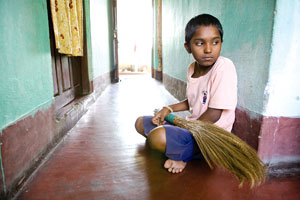 DAVID DUCHEMIN/WORLD EDUCATION |
Those are the numbers. But behind the appalling statistics are tragic individual stories of stolen childhoods, and of children who suffer physical and psychological abuse. Each story of abuse is an indictment of an uncaring state that has left its future citizens to fend for themselves. The political class is so busy politicking, it has no qualms about preying on the most vulnerable section of society.
They say you can tell a lot about a country from the way it treats its children. From the way we mistreat ours, our criminal neglect in not giving them normal childhoods, we should be hanging our heads in shame. Nepal signed the UN Child Rights Convention in 1990 and other international treaties to protect children from the worst forms of child labour. Parliament passed the Child Protection Act in 1992 and the law prohibiting bonded child labour. Yet, as with many of our laws, they exist only in paper.
To be fair, there has been a sharp drop in the absolute numbers of child workers. The National Labour Force Survey of 2008 shows that child workers in the 5-15 age bracket dropped from 2 million in 1998 to 1.5 million in ten years. The number of older working children also showed a decline as the carpet and pashmina industries collapsed, spreading education brought down the number of bonded labourers, and the expansion of road networks reduced the number of children working as porters.
However, there has been an alarming increase in the number of children in the 15-17 age bracket who are working in exploitative sectors like brick factories, domestic work, fabric embroidery, manufacturing, garages, and in the sex industry. The national-level exclusion of marginalised groups from decision-making is also reflected in the children. A Rapid Assessment survey conducted by World Education and Plan International this year showed that nearly half the children in a sample group working in brick factories were Janajatis and 20 per cent were Dalits. The figures are similar for tea shops, restaurants, and domestics. More girls than boys were found to be working, and 60 per cent of those toiling in hazardous circumstances were, in fact, girls.
The opportunity cost of such staggering numbers represents a huge loss to the nation. The repercussions of this will be felt long into the future as the child workers of today grow into teenagers, young adults and citizens of tomorrow.
The government has re-adjusted the targets and now says it wants to ban the worst forms of child labour by 2016 and all child labour by 2020. Given the political disarray, the lack of focus on service delivery, the public's lack of awareness and even acceptance by families of child labour, it will be a challenge to meet even those extended targets.
More worrisome is the progress Nepal made in child and maternal survival in the past 15 years seems to have stalled largely due to a plateauing in the female literacy rate. This is bound to have an impact on efforts to reduce the number of child workers as well.
Political transition can no longer be an excuse. We have to get our children out of the workplace and into schools, and we have eight more years to complete that task.
Read also:
Lost innocence
Cheated of their childhood, BHRIKUTI RAI
There are fewer Nepali boys and girls working, but the ones who do are in dangerous occupations


